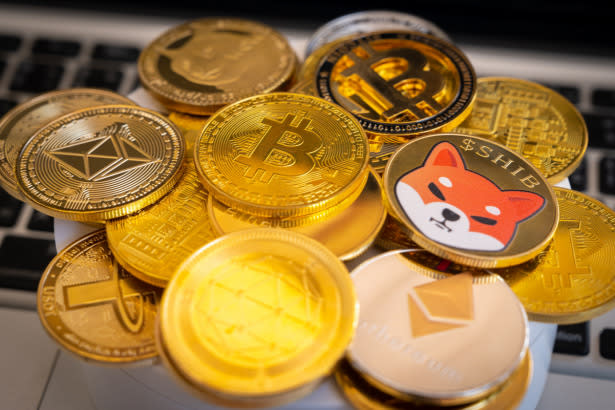News


What Is Toncoin (TON)?
Toncoin (TON) is a decentralized cryptocurrency that operates on the TON blockchain platform. TON is the native cryptocurrency of the Telegram Open Network (TON), a blockchain project developed by the team behind the popular messaging app Telegram.
Here is some detailed information about Toncoin (TON):
1. Background: The Telegram Open Network (TON) was initially announced in 2017 by Pavel Durov, the founder of Telegram. The project aimed to create a fast, scalable, and secure blockchain platform that could handle millions of transactions per second.
2. Technology: TON is built on a proof-of-stake consensus mechanism called the “Byzantine Fault Tolerant” (BFT) protocol, which is designed to provide high levels of security and scalability. The TON blockchain also features a smart contract platform that allows developers to create decentralized applications (dApps) and digital assets.
3. Use Cases: Toncoin (TON) can be used for various purposes within the TON ecosystem, including paying for transaction fees, participating in decentralized governance, and interacting with dApps built on the platform. TON can also be used for peer-to-peer transactions and as a store of value.
4. Tokenomics: The total supply of Toncoin (TON) is capped at a certain amount, and new coins are minted through the staking process. Users can earn rewards by staking their TON coins and participating in the network’s consensus mechanism.
5. Regulatory Challenges: The development of the Telegram Open Network (TON) and the Toncoin (TON) cryptocurrency faced regulatory challenges, leading to delays and legal issues. In 2020, the U.S. Securities and Exchange Commission (SEC) filed a lawsuit against Telegram, alleging that the initial coin offering (ICO) for TON violated securities laws.
6. Current Status: As of now, the status of the Telegram Open Network (TON) project and the Toncoin (TON) cryptocurrency remains uncertain due to the legal challenges and regulatory issues. The project’s development has been put on hold, and the future of TON is unclear.
Overall, Toncoin (TON) is a cryptocurrency that was designed to power the Telegram Open Network (TON) platform and provide a decentralized infrastructure for secure and scalable blockchain applications. However, the project has faced significant hurdles, and its future remains uncertain.
Toncoin (TON) was founded by Pavel Durov, a Russian entrepreneur and programmer who is best known as the founder of the popular messaging app Telegram.
Here is some detailed information about Pavel Durov and his role in founding Toncoin (TON):
1. Pavel Durov: Pavel Durov was born on October 10, 1984, in Leningrad, Soviet Union (now Saint Petersburg, Russia). He studied philology at Saint Petersburg State University and later pursued a career in programming and entrepreneurship.
2. Founding of Telegram: In 2013, Pavel Durov co-founded Telegram Messenger LLP along with his brother Nikolai Durov. Telegram is a cloud-based instant messaging service known for its focus on security, privacy, and encryption. The app quickly gained popularity and became one of the leading messaging platforms globally.
3. Announcement of TON: In 2017, Pavel Durov announced the Telegram Open Network (TON) project, a blockchain platform that aimed to revolutionize the world of cryptocurrencies and decentralized applications. Durov envisioned TON as a fast, scalable, and secure blockchain platform that could handle millions of transactions per second.
4. Development of Toncoin (TON): As part of the Telegram Open Network (TON) project, Toncoin (TON) was created as the native cryptocurrency of the platform. TON was designed to serve as a utility token for various functions within the TON ecosystem, such as paying for transaction fees, participating in governance, and interacting with decentralized applications.
5. Legal Challenges: Despite the ambitious vision for TON and Toncoin, the project faced legal challenges and regulatory hurdles, particularly in the United States. The U.S. Securities and Exchange Commission (SEC) filed a lawsuit against Telegram in 2020, alleging that the initial coin offering (ICO) for TON violated securities laws.
6. Current Status: The legal challenges and regulatory issues surrounding TON and Toncoin have led to delays and uncertainty regarding the future of the project. As of now, the development of TON has been put on hold, and the project’s status remains unclear.
Overall, Pavel Durov played a key role in founding Toncoin (TON) as part of the Telegram Open Network (TON) project. His vision for a decentralized and secure blockchain platform aimed to push the boundaries of blockchain technology, although the project has faced significant challenges along the way.
Toncoin (TON) has several unique features and characteristics that set it apart from other cryptocurrencies.
Here is some detailed information on what makes Toncoin (TON) unique:
1. Integration with Telegram: One of the key aspects that make Toncoin (TON) unique is its integration with the popular messaging app Telegram. The Telegram Open Network (TON) project was initiated by Pavel Durov, the founder of Telegram, and Toncoin was designed to be the native cryptocurrency of the TON blockchain platform. This integration with Telegram gives Toncoin access to a large user base and potential for widespread adoption.
2. Scalability and Speed: Toncoin (TON) aims to address the scalability and speed issues faced by many blockchain platforms. The TON blockchain is designed to handle a high throughput of transactions, with the goal of processing millions of transactions per second. This scalability and speed make Toncoin suitable for various use cases, including decentralized applications (dApps) and micropayments.
3. Proof-of-Stake Consensus: Toncoin (TON) operates on a proof-of-stake (PoS) consensus mechanism called the Byzantine Fault Tolerant (BFT) protocol. PoS consensus mechanisms are known for their energy efficiency and security, as they do not require the same computational power as proof-of-work (PoW) systems. The BFT protocol enhances the security and reliability of the TON blockchain.
4. Smart Contracts and dApps: Toncoin (TON) supports smart contracts and decentralized applications (dApps) on its blockchain platform. Smart contracts are self-executing contracts with predefined rules and conditions, enabling automated and trustless transactions. Developers can build a wide range of dApps on the TON blockchain, creating a diverse ecosystem of decentralized services.
5. Governance and Staking: Toncoin (TON) holders have the opportunity to participate in the governance of the TON blockchain by staking their coins. Staking involves locking up a certain amount of TON coins to support the network’s operations and security. In return, stakers may receive rewards in the form of additional TON coins. This governance model promotes decentralization and community participation.
6. Legal Challenges and Resilience: Despite facing legal challenges and regulatory hurdles, Toncoin (TON) has demonstrated resilience and adaptability. The project has navigated through legal issues and continues to explore ways to move forward. This ability to overcome obstacles and maintain focus on its goals sets Toncoin apart in the cryptocurrency space.
In conclusion, Toncoin (TON) stands out for its integration with Telegram, scalability, PoS consensus mechanism, support for smart contracts and dApps, governance model, and resilience in the face of challenges. These unique features contribute to Toncoin’s potential to become a significant player in the blockchain and cryptocurrency ecosystem.
The exact number of Toncoin (TON) coins in circulation may vary due to factors such as staking rewards, token burns, and network activity.
Some general information about the total supply and distribution of Toncoin (TON):
1. Total Supply: The total supply of Toncoin (TON) is predetermined and capped at a certain amount. This total supply is typically determined at the launch of the cryptocurrency and can vary depending on the project’s tokenomics. The total supply of Toncoin sets the maximum number of coins that can ever exist.
2. Initial Distribution: When Toncoin (TON) was launched, the initial distribution of coins may have included allocations for the development team, early investors, advisors, and other stakeholders. These initial allocations help fund the project’s development and ecosystem growth.
3. Staking Rewards: Users can earn additional Toncoin (TON) coins by participating in the network’s staking mechanism. Staking involves locking up a certain amount of TON coins to support the network’s operations and security. In return, stakers may receive rewards in the form of newly minted TON coins. These staking rewards contribute to the circulating supply of Toncoin.
4. Token Burns: Some blockchain projects implement token burn mechanisms to reduce the total supply of coins over time. Token burns involve permanently removing coins from circulation, typically by sending them to a burn address where they are unrecoverable. Token burns can help increase scarcity and potentially drive up the value of the remaining coins.
5. Circulating Supply: The circulating supply of Toncoin (TON) refers to the number of coins that are actively being traded on the market. This circulating supply may be lower than the total supply due to factors such as coins held in long-term storage, locked-up in smart contracts, or not actively traded.
It’s important to note that the specific details of Toncoin’s circulating supply, total supply, and distribution may change over time as the project evolves and new information becomes available. For the most up-to-date information on Toncoin (TON) coins in circulation, you may refer to official project announcements, blockchain explorers, and cryptocurrency market data websites.
The Toncoin (TON) network is secured through a combination of cryptographic techniques, consensus mechanisms, and network design principles.
Here is detailed information on how the Toncoin (TON) network is secured:
1. Byzantine Fault Tolerant (BFT) Protocol: Toncoin (TON) operates on a Byzantine Fault Tolerant (BFT) consensus protocol. The BFT protocol is designed to ensure the security and reliability of the network by tolerating Byzantine faults, where nodes in the network may act maliciously or fail to operate correctly. This consensus mechanism helps prevent double-spending and other attacks on the network.
2. Proof-of-Stake (PoS) Consensus: Toncoin (TON) uses a proof-of-stake (PoS) consensus mechanism to validate transactions and secure the network. In a PoS system, validators are chosen to create new blocks and validate transactions based on the number of coins they hold and are willing to “stake” as collateral. PoS is known for its energy efficiency and security compared to proof-of-work (PoW) systems.
3. Validator Nodes: In the Toncoin (TON) network, validator nodes play a crucial role in securing the blockchain and validating transactions. Validators are responsible for proposing and validating new blocks, reaching consensus on the state of the blockchain, and ensuring the integrity of the network. Validator nodes help maintain the decentralized nature of the network and prevent single points of failure.
4. Decentralization: The Toncoin (TON) network is designed to be decentralized, with multiple validator nodes distributed across the network. Decentralization helps prevent censorship, collusion, and other attacks that could compromise the security of the network. By distributing control and decision-making power among a diverse set of validators, the network becomes more resilient to attacks.
5. Economic Incentives: The Toncoin (TON) network incentivizes validators to act honestly and secure the network through economic rewards. Validators who participate in block validation and maintain the network’s integrity are rewarded with TON coins. These economic incentives encourage validators to uphold the security and stability of the network.
6. Security Audits and Upgrades: To maintain the security of the Toncoin (TON) network, regular security audits and upgrades may be conducted to identify and address potential vulnerabilities. By continuously monitoring the network for security risks and implementing necessary improvements, the Toncoin network can enhance its resilience against potential threats.
Overall, the Toncoin (TON) network is secured through a combination of the BFT consensus protocol, PoS mechanism, validator nodes, decentralization, economic incentives, and ongoing security measures. These security features work together to protect the network from malicious actors, ensure the integrity of transactions, and maintain the overall security of the Toncoin blockchain.
Start trading with 100,000 USD on your demo account without risking real money. Gain experience with your dedicated investment advisor. When you are ready, take your first step into the world’s largest market!
WhatsApp us
